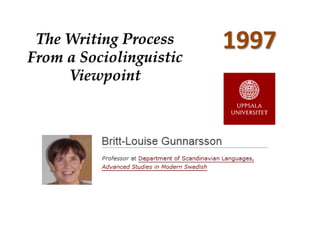
Presentation 2 Elizabeth Narváez Cardona
- 1. 1997
- 2. 1997
- 3. The author´s argument is… The challenges of writing within an organization
- 5. The theoretical framework for studies in modern societies The study focus are processes and products communication, either for distant or everyday interaction, within a group or organization. Communication, including speech as well as writing, is essential to the group culture (norms and attitudes), and identity. The individuals are of interest as members of the groups or organizations. The individuals are given certain roles within the structure of the organization, have certain places within the group hierarchy. Internal structure and external networks influence communication at every level. The larger community forms the more stable and widespread genres. It is the communicative group, however, that chooses to use certain genres and not others, that mixes them and gives them their variant forms.
- 6. Methodological approach according to the theoretical framework The variables involved in describing a communicative group: Size and duration of the group. The medium by which different types of information are conveyed within the group. How different individuals communicate with each other to attain different goals. The internal structure of a group is related to the parameters of hierarchy and cluster. The openness of the group can in turn be assumed to be reflected in its uniformity, which will be manifested in shared knowledge, evaluation, attitudes, and norms as to the patterns and use of writing and speech.
- 7. Applying the sociolinguistic framework A case of study The research´s aims Analyzing: The organizational structure and its effects on writing at work. The communicative process and the role of spoken discourse and collaboration in the constructions of documents of various kinds. The possible existence of group uniformity as it pertains to norms, attitudes, and identity vis-á- vis writing.
- 8. Applying the sociolinguistic framework The data collection and analysis Qualitative and quantitative analysis were conducted for the following data collection 1. A questionnaire (26 questions and 33 employees answered the questionnaire) Types of texts they wrote and how frequently Writing procedures Incidents of collaboration with colleagues Their role in relation to the texts they wrote The influence on writing norms and patterns at the office Their attitudes toward writing at work 2. Interviews: 6 members of the staff in different positions and with varying bureaucratic experience were interviewed. 3. A set of texts: which were analyzed according to the type of text, addressee, signature, sender, and purpose.
- 9. Hypothesis emerging from the study High positions reported more difficulties; the author related this with the length of the documents and the high stakes that they impose. Therefore, the assumption is: if writing task has high challenges, larger and complex planning processes are needed because of more difficulties to write could emerge. The high-stake texts mostly undergo both intensive planning and revision processes. Overall, these types of texts are written by higher positions in the organizations, because these documents address to interlocutors who are outside of the immediate setting and thus are more sophisticated texts. Moreover, these texts could be seen as high-stake texts, because in some extent they are related to how the organizations obtain their resources for being sustainable through time. There are a text hierarchy based on the importance of the document that in turn depends on the addressee. The collaboration for writing tends to happen among higher positions in a social organization. If the job position is located in the highest ranks within the hierarchy, there will be more sophisticated writing processes; therefore, collaborators are mostly peers or colleagues.
- 10. Conclusions Texts and talks intertwined depend highly on hierarchical positions. The higher the position the longer and more complex the communicative chains. Ideas about the organization and work in general were found to be reflected in norms and attitudes vis-á-vis writing at work. Internal structure of organizations, role patterns, external relations, and group uniformity are important focus of study if researchers would like to understand what takes place in writing in real-life settings.